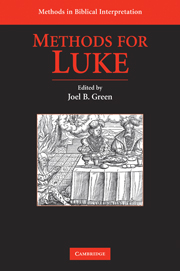2 - Historical Criticism
Published online by Cambridge University Press: 05 June 2012
Summary
The historical–critical method encompasses a variety of strategies for eliciting meaning from a premodern literary text. The most prominent of these subspecies are text, source, form, redaction, rhetorical, and social-scientific criticism. Although distinctive, each approach prioritizes comparative analysis of a text in its literary and historical contexts – involving cultural, social, political, religious, and other aspects. An investigation of early Christian texts from a historical–critical perspective implies close examination of a passage using any or all of the pertinent critical techniques listed previously.
In this chapter I sketch the emergence of the historical–critical method in the field of biblical studies and describe its suitability for understanding the Gospel of Luke. Following this background, I analyze Luke 20:45–21:4 by means of this method, showing how manipulation of traditional source material, in this case the author's version of Mark, best explains the author's narrative strategy, which in turn helps to reveal the author's first goal: to write the first credible history of early Christianity.
A BRIEF HISTORY OF THE HISTORICAL–CRITICAL METHOD
“Higher criticism” was the name given to study of the Bible as any other fancient text, that is, as composed by human beings during particular phases in history. In contrast, “lower criticism” was the attempt to understand biblical texts on the basis of internal evidence alone. The Dutch scholar Erasmus (1466–1536) might be credited as the first to study the Bible critically, although many of his methods are identifiable in the work of earlier scholars and theologians.
- Type
- Chapter
- Information
- Methods for Luke , pp. 9 - 41Publisher: Cambridge University PressPrint publication year: 2010

